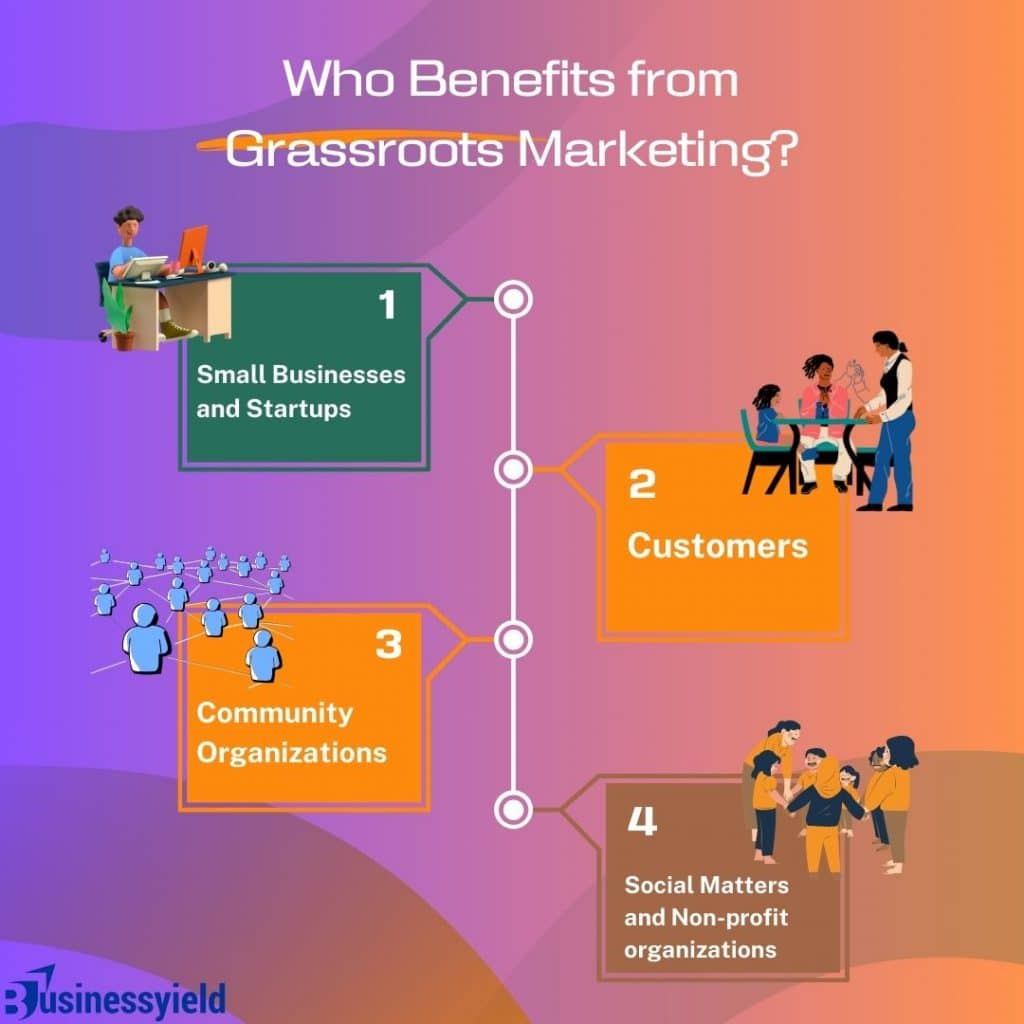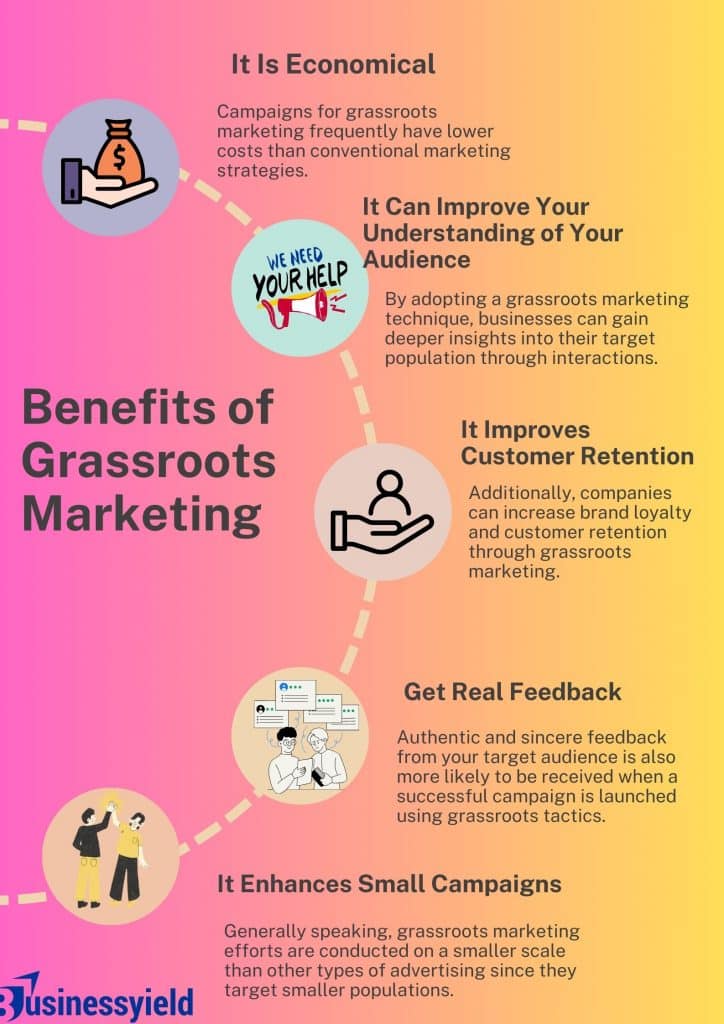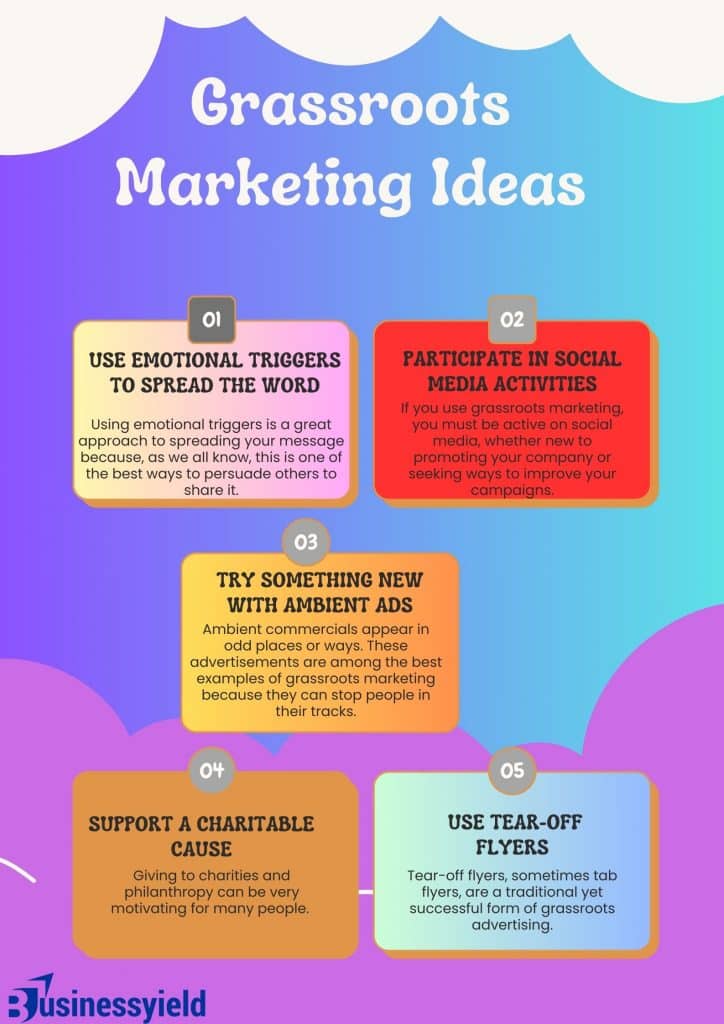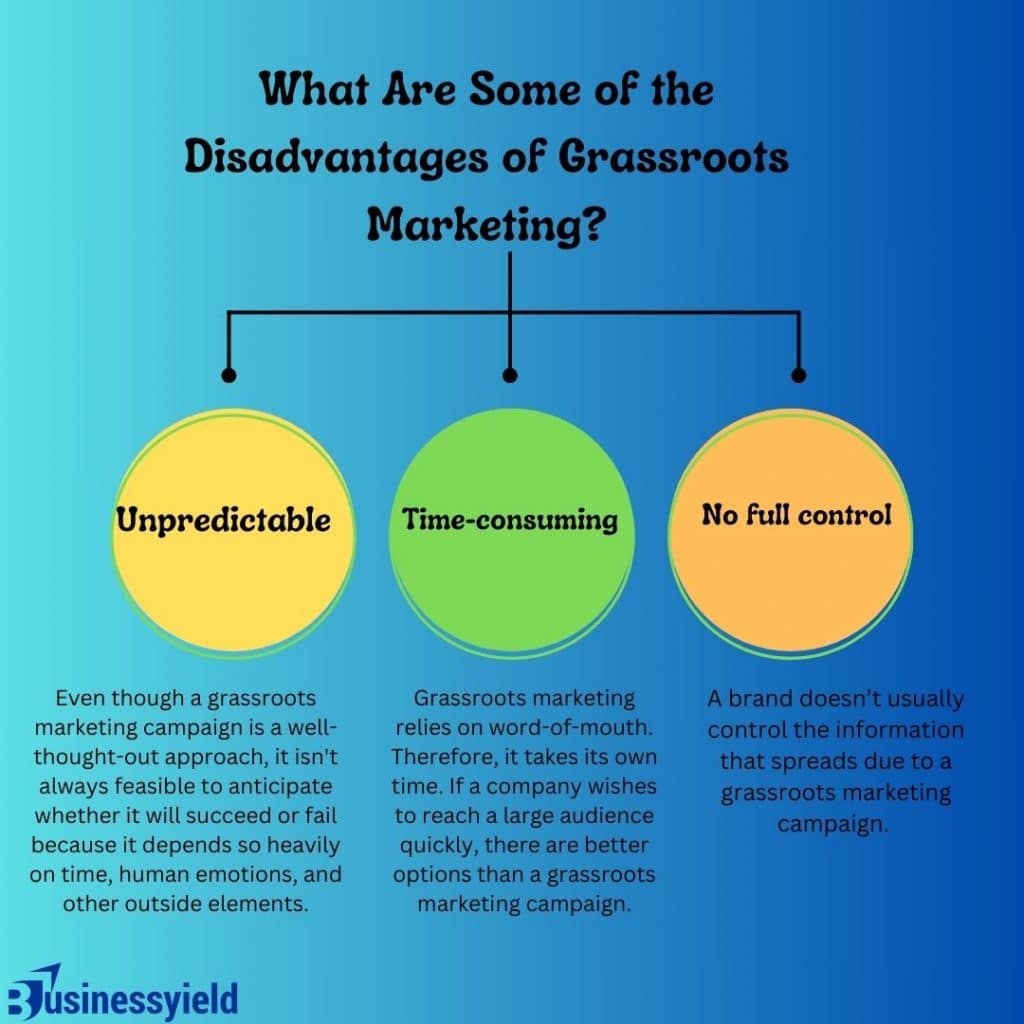It’s not always easy to increase a brand’s visibility and build brand awareness, particularly when creating an effective marketing plan. One strategy businesses use to reach a wider audience is grassroots marketing. Regardless of how saturated the market is, grassroots marketing and advertising techniques can help you outsell your competitors while maximizing your reach and visibility in any market. In this article, I will explain in detail what grassroots marketing is all about, with some examples and ideas.
Key Points
- Grassroots marketing is a strategy focused on reaching niche audiences at a local level through community involvement, word-of-mouth, and organic engagement.
- Grassroots campaigns target a specific audience niche or demographic, whereas guerilla marketing campaigns are often designed to reach as many people as possible through viral social sharing. However, both campaigns can use the same strategies and techniques.
- Small businesses and startups, customers, community organizations, social causes, and non-profit organizations are some of the people who benefit from grassroots marketing campaigns.
What is Grassroots Marketing?
Grassroots marketing for small businesses involves generating interest in a product, brand, or idea using a targeted and highly niche audience. While many marketing strategies aim to reach as many people as possible, a grassroots marketing strategy seeks to interact with a more intimate group and motivate them to spread the word about the brand. This is less of a top-down plan and more of a bottom-up approach than standard marketing techniques.
Though the two are frequently used interchangeably, guerrilla marketing is a tactic that draws attention without concentrating on a specific target market. Both guerrilla and grassroots campaigns are visually striking, provocative, and emotionally charged; however, they highlight particular individuals or groups to amplify their message and compel the audience to take action.
How Has Grassroots Marketing Evolved?: Evolution

Having spent my childhood in Los Angeles, I cherish memories of navigating the bustling avenues of Hollywood with my father. Amidst the crowds of people, we were incessantly approached by individuals extending flyers, vying for our attention. Most of the time, we had no idea what kind of goods or services they were marketing, which occasionally caused us trouble when we found out they were cabaret-related. If nothing else, the grassroots initiative proved successful since our curiosity overcame us. A five-second elevator pitch, or a form of a call to action, shouted enough to be heard over the raucous streets, can be added by those extremely driven grassroots marketers. There were many strategies with varying degrees of effectiveness, but the flyer was consistently the medium of message delivery.
Innovation Modifies the Rules

Naturally, at that time, there were no smartphones or internet. The game has evolved. Not only do brands engage with us more deeply, but they also divert our attention more readily. We get a ton of offers in our inbox every morning. Since they add clutter to our lives, flyers should be avoided like the plague. The grassroots marketing definition needed to evolve. Street teams, born out of the radio industry and the collapsing record business, brought the word to the masses. Street teams could attract specific clients and give them an experience centered around their brand by organizing branded events. Although successful, they frequently fell short of the ROI advertisers sought.
Present-Day Grassroots Marketing
Currently, grassroots marketing is highly scientific. Intelligent grassroots marketing incorporates all media into its plan to execute in a provable manner that yields a low CPM (cost per thousand) return on investment. Experience-based activations have replaced event and street marketing. It’s no longer the case that a college student needing hours can use grassroots marketing as a side gig. Teams now need to receive cross-training in nurturing and lead conversions. For any brand, grassroots marketing is the least common denominator. This is the starting point and frequently the entryway for your buyer’s trip; your staff is the guardian.
Coordination in execution is essential, and strategy is crucial. For grassroots marketing to be more than just a branding exercise, a single, obvious call to action—the conversion—must be included in your out-of-home, TV, radio, print, and other traditional media campaigns. The days of fishbowls filled with business cards and entry pads are long gone. Thanks to technology, we can start a brand relationship with only a few basic questions on an iPad, a well-placed hashtag in a photo, or a Facebook page.
What was once a push-marketing strategy is now an inbound marketing strategy. Though trendy as T-shirts and keychains can be, a grassroots marketer of today needs to think about the offer your team will make rather than the amount. The team needs the potential customer to succeed in their mission.
Although the grassroots definition has changed over the past fifteen years, it is still among the most economical marketing strategies. Once an affordable point-of-purchase return investment, it is now a crucial component of many effective inbound marketing strategies.
What Is the Difference Between Grassroots Marketing and Guerilla Marketing?
Grassroots marketing and guerilla marketing are often confused. This is understandable, given that grassroots marketing usually relies on many of the same techniques as guerilla marketing campaigns.

This ambient ad does not target a specific group or demographic. Image source: Ad Ruby
However, the key difference goes back to audience and intent; grassroots campaigns target a very specific audience niche or demographic, whereas guerilla marketing campaigns are often designed to reach as many people as possible through viral social sharing, even though both types of campaigns can use the same strategies and techniques.
Admittedly, this isn’t the clearest distinction between the two, but remember that true grassroots campaigns begin with—and rely upon—targeting a highly specific group of people.
Who Benefits from Grassroots Marketing?

A grassroots campaign will have unique characteristics compared to a traditional marketing campaign or even a guerilla marketing technique. Targeting particular demographics and speciality groups is crucial when implementing a grassroots marketing plan to promote a company, brand, idea, or product. Examples of grassroots marketing could be:
#1. Small Businesses and Startups
For startups and small businesses with tight funds, grassroots marketing can be especially helpful. By interacting directly with their target demographic in their local communities, these companies can boost brand awareness and customer loyalty without investing a lot of money in typical advertising efforts. They can build a personal rapport with potential customers through grassroots initiatives, resulting in enduring partnerships and recurring revenue.
#2. Customers
Developing real relationships with customers is a common component of grassroots marketing, as opposed to inundating them with faceless commercials. Customers value grassroots marketing’s genuineness and authenticity because it can promote brand trust. Furthermore, collaborations or community activities are common in grassroots marketing campaigns, giving customers chances for deep connection and engagement with the business.
#3. Community Organizations
Collaboration with nearby charities, events, and community organizations is common in grassroots marketing campaigns. Organizations can show their support for local causes and dedication to the community by endorsing and participating in these projects. This builds a community connection and improves the brand’s reputation.
Through grassroots support mobilization and awareness-raising, grassroots marketing can benefit nonprofit organizations and social issues. By interacting with groups and people who are enthusiastic about the cause, nonprofits can spread their message and draw volunteers, funders, and advocates.
Benefits of Grassroots Marketing

A grassroots marketing strategy can provide organizations with several advantages. Even though it’s essential to include a variety of tactics when developing a marketing strategy, think about integrating a grassroots campaign into your overall strategy. A few advantages of grassroots marketing initiatives are as follows:
#1. It Is Economical
Campaigns for grassroots marketing frequently have lower costs than conventional marketing strategies. Using a grassroots approach, you aim to reach a limited audience instead of reaching as many people as possible. Reaching a larger audience usually results in higher costs; thus, going grassroots is one of the more economical solutions.
A strong social media presence is frequently essential to grassroots marketing. Businesses can freely promote their marketing messages on most social media platforms because they are free to use. Because of this, grassroots campaigns are an excellent choice for smaller businesses or departments with tighter marketing expenditures.
#2. It Can Improve Your Understanding of Your Audience
By adopting a grassroots marketing technique, businesses can gain deeper insights into their target population through interactions. In addition to promoting their brand, businesses can use the grassroots marketing strategy to get input from their clientele. Firms often require further study to obtain this kind of feedback. Grassroots marketing is one way to help eliminate this requirement. After this crucial input, organizations can make more intelligent, customer-focused adjustments to their goods, services, customer interactions, and marketing messaging.
#3. It Improves Customer Retention
Additionally, companies can increase brand loyalty and customer retention through grassroots marketing. Encouraging customers to recommend your brand to their friends and family is key to brand marketing. The customer gains knowledge about other users of your brand and establishes a mutual interest as a result. A strong sense of community is among the most important elements in determining brand loyalty. By encouraging referrals and concentrating on smaller groups, grassroots marketing fosters the growth of this community.
#4. Get Real Feedback
Authentic and sincere feedback from your target audience is also more likely to be received when a successful campaign is launched using grassroots tactics. It can be beneficial to receive constructive criticism and input when refining and streamlining any further grassroots marketing ideas you may have.
#5. It Enhances Small Campaigns
Generally speaking, grassroots marketing efforts are conducted on a smaller scale than other types of advertising since they target smaller populations. A grassroots campaign is more successful than some smaller ones since it focuses on a particular group. This strategy can result in fresh marketing opportunities that efficiently reach the intended audience without exceeding the budget.
How to Start a Grassroots Advertising Campaign
Starting a grassroots advertising campaign requires careful planning and execution to effectively reach your target audience without a large budget or established infrastructure. Here, I have put down a well-detailed, downloadable checklist to help you get started:
A Businessyield Checklist Guide on How to Start a Grassroots Advertising Campaign
Grassroots Marketing Examples
After exploring grassroots marketing in more detail, we would benefit from examining a few unique examples to gain a deeper and more comprehensive knowledge of the concept.
#1. UNICEF: Likes Don’t Save Lives

In the early 2010s, social media users obsessively increased their Facebook likes and engagement. This made them use causes and play with people’s emotions, using pictures and videos of underprivileged humans, especially children.
Even though UNICEF appreciated the platform for creating an awareness stage, it was against using this technique to gain more likes. Hence, it came up with the Likes Don’t Save Lives campaign, which communicated that one needs money, not likes, to save a life.
#2. ALS Ice Bucket Challenge

The goal was to record someone else, or yourself covering someone else’s head in a bucket of cold water on film and then challenge another person to follow suit. If someone took up the challenge, they were expected to contribute financially to the ALS association. In 2014, this novel idea gained widespread attention and set off a series of events that raised awareness of ALS and promoted donations for related research. The goal was to encourage people to become involved and support a cause from its inception, which eventually developed into a national movement that caught everyone’s attention.
#3. The International Dairy Foods Association
The International Dairy Foods Association (IDFA) represents dairy manufacturers, marketers, and suppliers. 225 companies are members, representing about 85% of the dairy industry.
Campaign Goal: Use social media platforms to increase engagement and awareness of IDFA during National Dairy and Ice Cream Months.
Channel(s): Twitter, and Instagram
Results: Their top post was for Root Beer Float Day, which was shared by 45 people and reached 4,114 people. It reached over 2,600 people on Cheese Day in June. 1,583 people viewed their post on Sunday, July 19, National Ice Cream Day.
#4. One Fund Boston
A Cleveland man’s tweet of support sparked the hashtag #BostonStrong for One Fund Boston.
Campaign Goal: Raise funds for the Boston marathon bomb victims.
Channel(s): Twitter
Results: As a rallying cry of support, #bostonstrong appeared everywhere on social media, on T-shirts, on billboards, on sidewalks, in speeches, and eventually as a way to raise funds for the victims through One Fund Boston. In the first few hours after Clough’s tweet, #bostonstrong was used more than 1.5 million times.
#5. Dove Real Beauty Campaign

In the Dove Real Beauty Campaign, Dove got a forensic artist to draw women the way they picture themselves, and in a way, some other stranger did. This powerful video started a movement and inspired so many women to believe in themselves and see their real beauty. It forced people to think about the deep-rooted social conditioning that defines ‘ideal beauty standards’ for women.
Grassroots Marketing Ideas
Growing up in Los Angeles, I have personal experience with the effectiveness of grassroots marketing ideas. Several successful business owners consistently organize community events that have shown to be quite beneficial; from bake sales to neighbourhood clean-ups, every engagement has established real connections. Seeing marketers distribute posters at neighbourhood markets resulted in devoted customers who valued the effort. It was about sharing passion directly, not just about making a sale. These neighbourhood-based initiatives were more than just tactics; they were expressions of commitment to forming deep connections with the people in the neighbourhood.
You can begin developing workable grassroots marketing ideas that are best for your business and brand as soon as you decide to launch your grassroots advertising campaign. Here are some of the top grassroots marketing ideas I have put down for effective results:

#1. Use Emotional Triggers to Spread the Word
Using emotional triggers is a great approach to spreading your message because, as we all know, this is one of the best ways to persuade others to share it.
An excellent example of this idea is a grassroots initiative launched by Canadian budget airline WestJet. The airline polled customers on social media to find out what they most wanted to receive for Christmas. The airline then hurried out while the aircraft was still in the air, purchased a number of the gifts that the passengers had specified, and placed them on the luggage carousel to be given away to them upon landing.
With over 33 million views at the time and an additional 11 million views since, the campaign’s YouTube video has demonstrated the effectiveness of a positive, emotional message and the potential benefits of timely or seasonal marketing.
If you use grassroots marketing, you must be active on social media, whether new to promoting your company or seeking ways to improve your campaigns. Engaging in social media activity can assist you in monitoring the effectiveness of specific campaigns, postings, and advertisements you have started on the social media network of your choice.
Social media only takes a few clicks to identify and target particular demographics interested in your brand or company. Targeting specific groups offers special opportunities for further community-based marketing initiatives.
Social media is an excellent starting point for anyone looking to identify the target market most interested in their company. It also offers a global platform that can help you reach as many people as possible.
#3. Try Something New with Ambient Ads
Ambient commercials appear in odd places or ways. These advertisements are among the best examples of grassroots marketing because they can stop people in their tracks.
These examples demonstrate how using innovative ambient advertisements can help promote your brand. Hundreds of ambient ads are in action, and the issue deserves its page.
However, one of the few disadvantages of ambient advertising is that it can be costly, contingent upon the media, the cost of the available advertising inventory, and the campaign’s complexity. Each of these challenges is beyond the scope of this post, but ambient advertising may be worth exploring if you want to grab people’s attention.
#4. Support a Charitable Cause
Giving to charities and philanthropy can be very motivating for many people. Coming together to support a charity or advocacy organization can be a great way to promote your company and give vital support to organizations that depend on donations to assist those in need. The desire to support and be perceived as supporting a worthy cause can greatly boost grassroots marketing campaigns.
There are many examples of this in action, but one of the most potent that I can think of recently is the incredible acts of kindness that followed the Boston Marathon bombing and the #BostonStrong hashtag. The One Fund benefited greatly from this decentralized effort, which raised over $72 million in donations and enabled the organization to distribute almost $2 million to each victim’s family—a significant distinction given that the campaign started genuinely organically.
#5. Use Tear-Off Flyers
Tear-off flyers, sometimes tab flyers, are a traditional yet successful form of grassroots advertising. Usually, the top of these flyers has the advertisement or primary message, and smaller tabs with contact information or a call to action can be torn off and taken with interested parties.
Neighborhood businesses frequently use tear-off fliers to advertise local events, offerings, or services. For example, a local bakery might create tear-off flyers with tabs that offer a discount coupon or encourage visitors to visit their store, promoting a special bargain on freshly baked goodies. Likewise, a tutoring organization could post tear-off fliers offering free consultations for students and parents in high-traffic areas close to schools.
Also, tear-off flyers are a common tool that community organizations or event coordinators use to inform people about forthcoming activities or events. For example, a local animal shelter might design tear-off flyers with tabs that include information about the date, location, and contact details for questions to promote an adoption event.
Read also: Designing Effective Flyers for Schools and Universities: Tips and Best Practices
What Are Some of the Disadvantages of Grassroots Marketing?

Even though it comes with advantages, grassroots marketing also has cons, which can stop a business from choosing it as a marketing strategy. Here are some notable disadvantages:
- Unpredictable: Even though a grassroots marketing campaign is a well-thought-out approach, it isn’t always feasible to anticipate whether it will succeed or fail because it depends so heavily on time, human emotions, and other outside elements.
- Time-consuming: Grassroots marketing relies on word-of-mouth. Therefore, it takes its own time. If a company wishes to reach a large audience quickly, there are better options than a grassroots marketing campaign.
- No full control: A brand doesn’t usually control the information that spreads due to a grassroots marketing campaign. This could be a blunder for the company if people misunderstand the message.
Bottom Line
In conclusion, using grassroots marketing is not new, but it is extremely beneficial even in today’s ever-evolving online landscape. One way to help manage your digital grassroots marketing campaigns is to consider using AdStage. AdStage automates, creates, and manages campaigns across major PPC platforms and allows users to report on results. It can help you attract, engage, and nurture leads through grassroots marketing.






